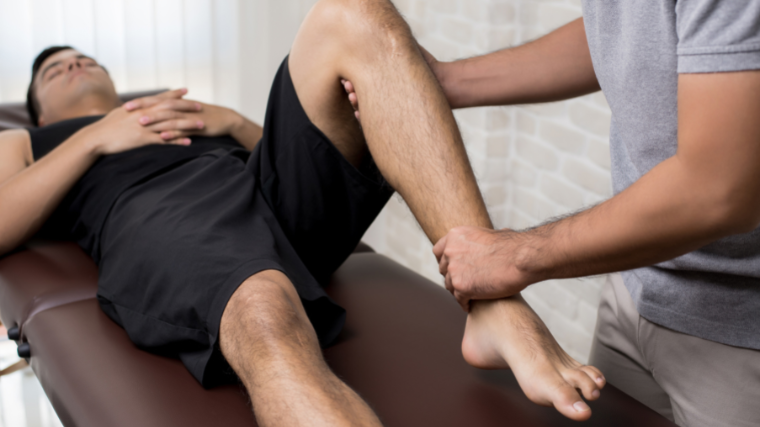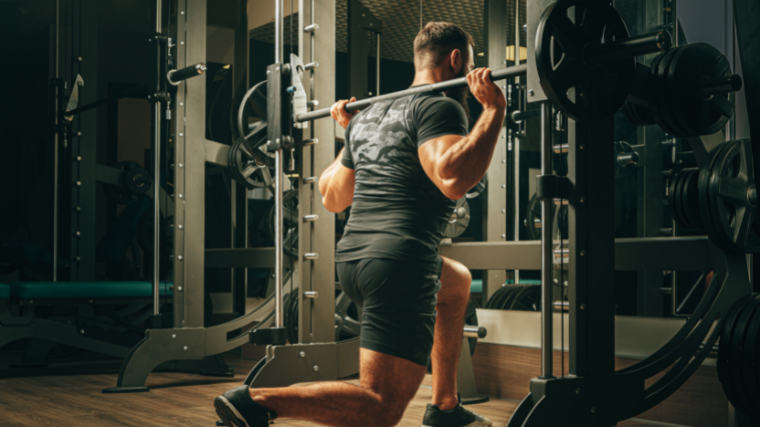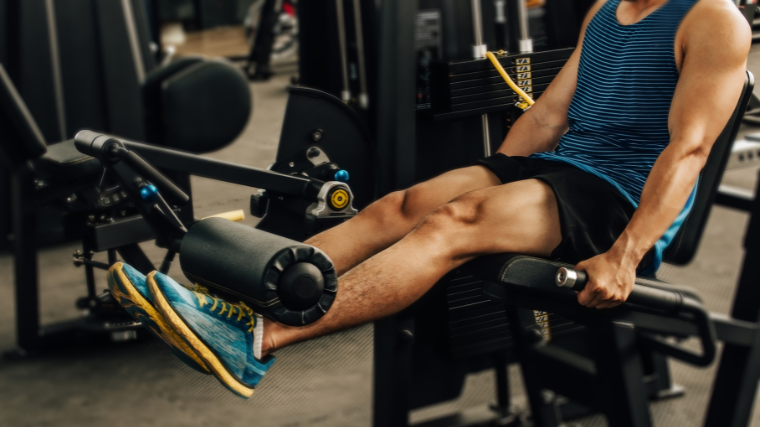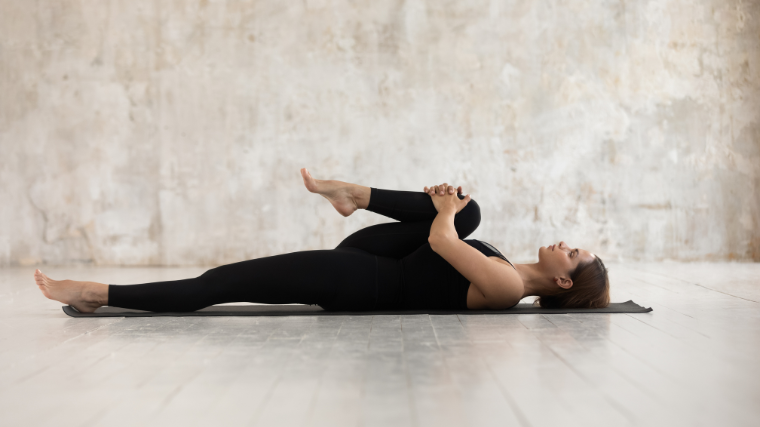You stroll into the health club pain-free. After going by way of your trusty squat warm-up, you apprehensively unrack the bar for the primary time, anxiously ready for a spasm or shockwave to radiate throughout your physique and allow you to know what sort of coaching day you’re in for.
Coping with an acute harm is a precarious place to be in for any leisure (or aggressive) energy athlete. Does a slipped disc or a pinched nerve herald the closure of your profession within the health club? Does a again harm imply you may by no means squat once more, or that you may not develop your legs?

No. Whereas accidents — be they a twinge or tweak, or one thing extra severe — are considerably widespread in energy coaching, they’re hardly ever a deadly blow to your exercises. Should you’re coping with a spine-related ailment, you’ll have thrown within the towel in your squats prematurely.
With the precise workout routines, a sound method to program design, and a wholesome quantity of respect on your personal limitations, leg coaching (and leg good points) aren’t off the desk, even for those who’ve bought a again harm.
Editor’s Notice: The content material on BarBend is supposed to be informative in nature, however it shouldn’t be taken as medical recommendation. When beginning a brand new coaching routine and/or weight loss plan, it’s all the time a good suggestion to seek the advice of with a trusted medical skilled. We’re not a medical useful resource. The opinions and articles on this web site are usually not supposed to be used as prognosis, prevention, and/or therapy of well being issues. They don’t seem to be substitutes for consulting a professional medical skilled.
Earlier than You Take Motion
Accidents occur in sports activities. From calisthenics to collegiate soccer to Brazilian Jiu-Jitsu, athletes of all disciplines and talent ranges are (principally) sure to tweak, sprain, or pull one thing ultimately. In that regard, weight coaching isn’t any exception.
The truth is, “sports activities diseases”, or low-level bodily illnesses that have an effect on your efficiency in a technique or one other, are astonishingly widespread, even in leisure weight lifting. Alternatively, catastrophic accidents that require vital medical interventions (like surgical procedure or a forged) are fairly uncommon. (1)

Regardless, it’s crucial that you simply defer to a professional medical skilled for those who’re frightened about your well being. No information you learn on-line, e-book you buy, or guru you comply with can correctly substitute for the care supplied by a doctor.
Should you’re presently affected by an harm, search steering out of your physician earlier than starting any type of strenuous train.
What Ache Is (and Isn’t)
Should you’re injured, it might really feel just like the doomsday clock is ticking. You could even be experiencing ache at, or round, the location of the harm. Know, although, that ache doesn’t all the time reside as much as its personal fame.
Ache Is Info
A big portion of these affected by accidents see their ache purely as some form of punishment, moderately than what it truly is — data. (2) On a organic stage, a ache response is just your physique’s try to tell you that one thing is amiss. Ache is the fireplace alarm, not the fireplace itself.
Ache Isn’t (All the time) a Downside
Acute ache says little about your bodily well being standing at any given time. As a substitute, you may consider ache as a protecting mechanism that permits you to know what you have to be conscious of internally.
Ache displays a terror of risk.
Fashionable analysis on ache science backs this, too. The supposition that acute ache is immediately indicative of a significant issue is slowly altering, and far of the scientific neighborhood now appreciates a separation between bodily ache and the harm itself.
A extra sensible solution to perceive ache is to consider it as a “recognizable somatic expertise that displays an individual’s apprehension of risk to their bodily or existential integrity.” (3)
Ache Is Momentary
Ache is transient. Whilst you’re extra prone to expertise vital ache within the hours and days immediately following an accident like a missed squat or deadlift try, you most likely aren’t going to be saddled with discomfort completely.
Your timescale when recovering from a again harm will range, as will the degrees of ache you expertise over that interval. (4)
Usually, there’s no rhyme or motive to once you’re in ache or aren’t, and it might not even immediately correlate to your behaviors in or out of the health club. Don’t change into too cautious of your present ranges of ache and lose sight of the massive image.
A very powerful factor to recollect is that, so long as you are taking time to correctly heal and recuperate, you’re not going to be in ache without end.
Ache Isn’t Correct
Experiencing acute or continual ache is just not all the time a helpful type of data for athletes. The truth is, the alternative might be true.
A surprisingly massive share of athletes who are suffering from disc-related illnesses expertise no hostile signs in any respect. (5) Conversely, it’s doable that the “supply” of your ache isn’t really coming from the compromised joint or tissue, however as a byproduct of neurological and even environmental components. (6)
If you’re experiencing ache, know that it doesn’t essentially correlate to the precise bodily standing of the place you’re at along with your well being. Nevertheless, that additionally doesn’t imply you must discard the data your physique offers you.
Ought to You Prepare Whereas Injured?
To get to the center of the difficulty, you might want to make an knowledgeable determination about whether or not you have to be stepping right into a squat rack in any respect for those who’ve bought an harm. Luckily, most analysis signifies that the reply is “sure.”
Coaching Helps Exterior the Health club
Accidents generally is a actual dampener to your temper and motivation. Those that undergo from an harm, be it gentle or extreme, usually tend to be a bit lax about their well being outdoors the burden room.

This may take the type of poor dietary adherence, elevated alcohol consumption, or subpar sleep hygiene. As such, even for those who’ve tweaked one thing, persevering with to coach might help present construction to your well being habits. (1)
Coaching Accelerates Restoration
It’s not groundbreaking, however it completely bears mentioning that lifting weights is restorative. So long as you retain your depth, quantity, and frequency in test, and don’t attempt to do an excessive amount of without delay, your leg exercises can have a optimistic affect on how shortly you bounce again from an harm. (7)
Coaching Makes You Really feel Higher
Equally to being bodily rehabilitative, resistance coaching may also help with the psychological rigors of battling an harm. (7)
Bodily going to the health club and dealing by way of resistance-based or calisthenic actions generally is a enormous boon to your temper and mindset, in addition to function an efficient reminder that you simply’re not “damaged.”
“Train will increase blood circulate, serving to to shuttle inflammatory chemical compounds and waste merchandise,” says Dr. Zachary Lengthy, Physician of Bodily Remedy and proprietor of The Barbell Physio. “Additional, bodily exercise additionally releases endorphins, which have a pain-relieving impact all their very own.”
Coaching Isn’t All the time Helpful
Though persevering with to carry whereas injured could be the precise transfer, you shouldn’t essentially rush again into your energy program proper after an accident.
Your physique shall be very trustworthy with you about whether or not or not you may tolerate lifting weights. A little bit of discomfort right here and there’s one factor, however for those who’re in noticeable ache throughout — and even earlier than — your warm-up units, you’re most likely doing extra hurt than good.
Hearken to your physique and, extra importantly, the phrase of your doctor earlier than you resolve to get energetic.
Methods to Prepare Legs Whereas Injured
Coaching by way of an harm isn’t so simple as going by way of your common exercise with a bit much less weight, however it isn’t all that difficult both. You’ll be able to nonetheless get a banger of a leg day in so long as you are taking the precise precautions.
Step 1 — Discover Your Baseline
The first step when attempting to coach legs below the duress of harm is to evaluate the place you’re at. It’s essential precisely decide what your tolerance is to train so you know the way arduous you may work safely.
To do that, begin from the bottom, actually, and work your method up. Should you can do a lifeless bug on the ground, you realize you may flex and prolong your leg safely. From there, transfer on to a body weight squat. If that’s clear, seize a dumbbell and take a look at your tolerance to goblet squats, and so forth.
Analysis signifies that resistance coaching is especially efficient at stopping “deconditioning” and managing your sensitivity to ache. (8)
Should you take issues too simply within the health club, you may inadvertently set your self as much as be too reactionary to any stray sensations that you simply’d usually not discover.
Step 2 — Heat-Up Completely
Heat-ups are essential for performing nicely within the health club, whether or not you’re injured or not. That mentioned, the literature hasn’t conclusively decided if a pre-exercise warm-up demonstrably reduces your threat of acute, activity-related harm. (9)
Regardless, an excellent warm-up might help in different methods. Growing your core temperature, inspiring some motion confidence, and step by step exposing your self to tougher challenges all assist make sure you’re correctly ready to coach.
Step 3 — Modify Your Actions (as Wanted)
You aren’t married to anyone motion within the weight room — even for those who’re a profession powerlifter. Working round a backbone harm may imply passing up on again squats for a friendlier different.
As an illustration, loads of literature factors to entrance squats or goblet squats as a viable back-friendly substitute. (10) You’ll typically discover that the extra horizontal distance there’s between your decrease again and the burden you’re working with, known as a second arm, the more durable it’s in your backbone.
As such, workout routines just like the entice bar deadlift could also be a snug alternative for barbell pulling, whereas the goblet or belt squat may permit you to squat with little to no ache in any respect.
Your relationship with motion is very particular person, and can possible take a little bit of trial-and-error.
Again-Pleasant Leg Workouts
No two our bodies (or accidents, for that matter) are the identical. As such, your private relationship with a given train might not be the identical as your health club accomplice’s. What ought to be a “protected” leg train on paper may trigger you ache, stress, or anxiousness.
Regardless, the next leg workout routines ought to permit you to prepare with an inexpensive diploma of consolation, relying on the precise nature of your harm. These actions are under no circumstances really helpful as therapy for an harm — they need to function a strong solution to work again into coaching.
Belt Squat
Most squatting actions are loaded axially, which means the burden rests on the backbone and creates compressive power. When you’ve got a disc or delicate tissue harm, spinal compression could set off a painful response.
The belt squat permits you to carry out a deep squat, however as a substitute of the burden pushing down in your skeleton from above, it pulls in your hips from under, creating traction.
Whereas spinal traction isn’t a well-backed therapy for again ache, (11) from a mechanical standpoint the belt squat creates a lot much less pressure in your backbone than a again or entrance squat would.
Field Squat
It’s doable that you simply solely get a flare-up or jolt of ache when working in a selected vary of movement. If two-thirds of your squat feels nice, however you may’t sink “ass to grass” as you usually do, you may deliver a field into the equation.
Field squats are a really easy method of turning the squat right into a partial-range-of-motion motion. By firmly limiting how deep you may squat, you may nonetheless prepare arduous and heavy with out worrying that you simply’ll by chance wander right into a painful vary.
Tempo Squat
Should you’re experiencing low again ache, you possible rely extra on your core musculature than you in any other case would. (12) As such, correctly bracing and fascinating your abs throughout compound leg actions is of the utmost significance.
Tempo coaching lets you just do that. By rising the length of your eccentric motion, you give your self sufficient time to deal with sustaining correct approach and a comfortable and safe brace.
Lengthy echoes this concept, stating that tempo work helps make mild weights really feel heavy, which can permit you to get a strong coaching stimulus with out incurring ache.
Goblet Squat (Normal or 1 & ½-Rep)
Anterior, or front-loaded squats, place much less of a mechanical demand in your decrease again and hips in comparison with your higher again and core. As such, a goblet squat with a dumbbell (or kettlebell) is a superb beginning motion for those who’re coaching with an harm.
Not solely ought to the goblet squat make it easier to preserve an upright torso and strong brace, however the nature of the train additionally lets you safely and quickly exit the set for those who really feel a second of ache or discomfort. Merely let go of the burden and also you’re out of there.
Lengthy strongly endorses one-and-a-half-rep schemes for actions just like the goblet squat as they, “considerably improve your time below pressure to coach your quads with out requiring that you simply use a heavy weight.”
Hip Thrust
Coaching your posterior chain is simply as (if no more) vital than constructing your quads, however most glute and hamstring actions additionally place quite a lot of stress on the lumbar backbone.
The hip thrust is a uncommon exception. With correct approach, the hip thrust locations practically all of its load immediately onto the glutes and hamstrings, sparing your backbone.
Step-Up
Should you’re injured, it’s fairly widespread to have one facet of your physique choose up the slack to account for any weak spot across the web site of the harm. This can be a priceless protecting mechanism, however it might additionally result in imbalances in energy or posture.
To that finish, unilateral workout routines just like the step-up can function an efficient technique of treating side-to-side disparities which will contribute to, or worsen, again ache. (13)
From a sensible standpoint, single-leg step-ups are straightforward to carry out, require little to no exterior weight to be efficient, and permit you to stop the train instantly for those who start experiencing discomfort.
Machine Actions
You don’t have to depend on free weights to realize muscle. Whereas usually thought-about helpful just for rank learners, weight machines might be extremely helpful for those who’re coaching round an harm.
The fastened path of motion, excessive diploma of exterior stability, and distinctive loading parameters make machines just like the leg extension, leg curl, or hip abduction indispensable when you may’t depend on your typical units of squats and deadlifts.

[Read More: The Best Quad Exercises and Quad Workouts for Muscle Gain]
Think about making machine isolation workout routines a bigger portion of your total coaching quantity for those who’re unable to make use of heavy free-weight compound lifts.
Pattern Again-Pleasant Leg Exercise
One of many worst issues you are able to do whereas working by way of a again harm is to comply with a pre-written program that doesn’t account on your particular wants.
That mentioned, a pattern back-friendly leg day may also function a strong visualization of the ideas you must depend on whereas coaching your legs. This exercise on no account ensures protected passage by way of an harm, however it does put lots of the ideas talked about above into observe.
The Exercise
This exercise begins slowly and builds on itself, permitting you to pause, modify, or exit out at any level. You’ll additionally discover quite a lot of machine work to account for decrease time spent with the barbell.
- Heat-Up: 5-10 minutes on the treadmill or stair stepper.
- 90-90 Respiratory Drill: 2 rounds of 10 breaths.
- Useless Bug or Bear Plank: 3 x 20 seconds.
- Tempo Goblet Squat: 2 x 5
- Belt Squat: 3 x 8-10
- Hip Thrust: 2 x 12-15
- Leg Extension: 4 x 12-15
- Leg Curl: 4 x 12-15
- Cable Glute Kickback: 2 x 15
Methods to Progress With a Again Damage
Spinal trauma doesn’t imply it’s a must to forsake all types of progress within the health club. It simply may imply a short break from attempting to set a brand new private document within the squat.
As a substitute of catastrophizing over any doable lack of energy or dimension, you may flip your gaze elsewhere and take advantage of any “downtime” within the health club.
Make Use of Machines
Hypertrophy is pushed by a mix of mechanical pressure, muscle injury, and metabolic stress. You may get all three in spades from heavy squats, positive, however you may nonetheless construct a formidable quantity of muscle with machines and cable stations as nicely.
Should you’re managing an harm that necessitates much less time within the squat rack, you can also make up for that misplaced stimulation by rising your whole units, reps, or weight on leg machines or by way of isolation workout routines.
Give attention to Type
A bodily illness that stops you from lifting heavy does include a silver lining. Should you can’t work at excessive intensities, your solely possibility is to do quite a bit with a little bit — which suggests giving additional consideration to your approach.
Taking a step again from heavy leg coaching supplies you a chance to lace up your kind on lighter squats, pulls, or their variations. That focus to element ought to repay once you return to your regular exercises down the road.
Get Versatile
In case your harm bans you from the barbell totally, “correct” leg exercises could also be briefly off the desk. Within the occasion that you simply’re capable of be bodily energetic however have a low tolerance for exterior resistance, you may refocus your efforts towards mobility and loadless actions as a substitute.

Aerobics, calisthenics, and dynamic stretching all induce optimistic organic results that may affect your charge of restoration from harm. (14) Furthermore and in virtually all instances, any motion in any respect is best than none for those who’re nursing a tweaked again.
Work in your hip, knee, ankle, or higher again mobility whilst you’re ready to return to the weights, and also you’ll transfer higher when you get there.
Take Small Wins
Therapeutic a again harm (or any medical difficulty, for that matter) isn’t a swap that you simply flip. You received’t go from being in every day ache to flawless and free motion in a single day, even when your restoration is on level.
As such, make a remark of each small little bit of progress you make. Whether or not that’s feeling excited moderately than anxious about going to the health club, sticking to your at-home stretching or rehab routine for a full week, or hitting extra low or pain-free reps than you probably did the session prior.
Ahead momentum and a optimistic outlook can have a tangible, real-world affect on accidents. The placebo impact received’t remedy you, however it may well fairly actually cut back psychological — and bodily — anguish. (15)
Motion Is Drugs
Accidents suck, plain and easy. Whereas some within the iron recreation put on their sprains and slipped discs as a badge of honor or one thing they’ve “earned” by coaching lengthy sufficient, the truth is much much less glamorous.
Accidents derail your progress, deter your motivation, and dampen your enthusiasm for what must be a satisfying and satisfying exercise. On the upside, they’re additionally not everlasting, nor do accidents sentence you to mediocrity within the health club.
Ache science and rehabilitation practices have advanced previous the “relaxation and ice it” prescription of years previous. Any severe harm requires supervision by a professional medical skilled, however your journey again to the barbell also needs to contain the barbell itself.
Prepare conservatively, take it sluggish, hearken to your physician or bodily therapist, and also you’ll be again in combating form earlier than you realize it.
References
1. Strömbäck, E., Aasa, U., Gilenstam, Ok., & Berglund, L. (2018). Prevalence and Penalties of Accidents in Powerlifting: A Cross-sectional Research. Orthopaedic journal of sports activities medication, 6(5), 2325967118771016.
2. Bunzli, S., Smith, A., Schütze, R., Lin, I., & O’Sullivan, P. (2017). Making Sense of Low Again Ache and Ache-Associated Concern. The Journal of orthopaedic and sports activities bodily remedy, 47(9), 628–636.
3. Cohen, M., Quintner, J., & van Rysewyk, S. (2018). Reconsidering the Worldwide Affiliation for the Research of Ache definition of ache. Ache experiences, 3(2), e634.
4. Zhao, R. T., Kandil, A., Nguyen, D. V., Campos, L., Amin, N. H., & Chang, E. Y. (2020). Ache Notion in Taekwondo: Relationship to Damage, Expertise, and Time Loss. Sports activities medication worldwide open, 4(2), E53–E58.
5. Brinjikji, W., Luetmer, P. H., Comstock, B., Bresnahan, B. W., Chen, L. E., Deyo, R. A., Halabi, S., Turner, J. A., Avins, A. L., James, Ok., Wald, J. T., Kallmes, D. F., & Jarvik, J. G. (2015). Systematic literature evaluate of imaging options of spinal degeneration in asymptomatic populations. AJNR. American journal of neuroradiology, 36(4), 811–816.
6. Fillingim R. B. (2017). Particular person variations in ache: understanding the mosaic that makes ache private. Ache, 158 Suppl 1(Suppl 1), S11–S18.
7. Welch, N., Moran, Ok., Antony, J., Richter, C., Marshall, B., Coyle, J., Falvey, E., & Franklyn-Miller, A. (2015). The consequences of a free-weight-based resistance coaching intervention on ache, squat biomechanics and MRI-defined lumbar fats infiltration and purposeful cross-sectional space in these with continual low again. BMJ open sport & train medication, 1(1), e000050.
8. Vuori I. M. (2001). Dose-response of bodily exercise and low again ache, osteoarthritis, and osteoporosis. Drugs and science in sports activities and train, 33(6 Suppl), S551–610.
9. Soligard, T., Myklebust, G., Steffen, Ok., Holme, I., Silvers, H., Bizzini, M., Junge, A., Dvorak, J., Bahr, R., & Andersen, T. E. (2008). Complete warm-up programme to forestall accidents in younger feminine footballers: cluster randomised managed trial. BMJ (Medical analysis ed.), 337, a2469.
10. Yavuz, H. U., Erdağ, D., Amca, A. M., & Aritan, S. (2015). Kinematic and EMG actions throughout back and front squat variations in most masses. Journal of sports activities sciences, 33(10), 1058–1066.
11. Alrwaily, M., Almutiri, M., & Schneider, M. (2018). Evaluation of variability in traction interventions for sufferers with low again ache: a scientific evaluate. Chiropractic & guide therapies, 26, 35.
12. Seyed Hoseinpoor, T., Kahrizi, S., Mobini, B., & Naji, M. (2015). A comparability of belly muscle thickness modifications after a lifting job in topics with and with out continual low-back ache. Human components, 57(2), 208–217.
13. Yoo W. G. (2016). Impact of unilateral workout routines on low again ache in an city driver. Journal of bodily remedy science, 28(11), 3257–3258.
14. Gordon, R., & Bloxham, S. (2016). A Systematic Assessment of the Results of Train and Bodily Exercise on Non-Particular Persistent Low Again Ache. Healthcare (Basel, Switzerland), 4(2), 22.
15. Rossettini, G., Carlino, E., & Testa, M. (2018). Medical relevance of contextual components as triggers of placebo and nocebo results in musculoskeletal ache. BMC musculoskeletal problems, 19(1), 27.
Featured Picture: Srdjan Randjelovic / Shutterstock
